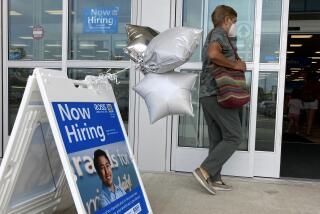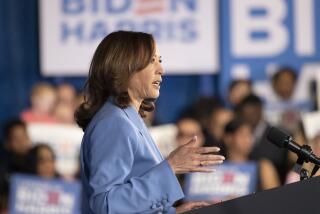On the road, Obama pushes plan to boost manufacturing
President Obama tried to give new hope to factory workers Wednesday as he promoted his plan to revive U.S. manufacturing, an anchor of the economic blueprint he sketched in his State of the Union address.
At a conveyor belt factory in Iowa and an advanced computer chip plant near Phoenix, the president pointed to tax policies he blamed for driving U.S. companies overseas and outlined his strategy to lure them back.
Obama becomes the latest president to promise to breathe new life into a sector of the U.S. economy that has been declining for decades. Thirty years ago, nearly one-fifth of U.S. jobs were in manufacturing. Today, less than 10% are, according to the Bureau of Labor Statistics. Like his predecessors, Obama will find that challenge formidable and complex, with little consensus on how to reverse the trend.
The political incentive is clear. The president has lost considerable support in the onetime industrial hubs of the Rust Belt and will need to woo more blue-collar voters to win reelection in November. With a slow economic recovery and a stubbornly high unemployment rate, the president’s ability to project a vision of an employed working class could determine his success.
“There’s no reason why we can’t restore that basic American promise that if you work hard, you can do well,” Obama told employees at the Cedar Rapids plant, his first stop on a five-state tour to promote the economic plan he unveiled in his speech before Congress on Tuesday night. “America’s not about handouts. America’s about earning everything you’ve got.”
The president’s plan relies largely on changing the tax code to discourage American companies from moving operations overseas in search of cheaper costs. He proposed doing away with deductions available to companies that close plants in the U.S., and he called for a new 20% income tax credit for companies that return.
He proposed tailoring a deduction for domestic production to apply more narrowly to manufacturing, leaving out oil production. The idea is to provide temporary tax credits to boost domestic manufacturing in clean energy.
Critics expressed skepticism about the president’s commitment to the effort and criticized his other tax proposals as counterproductive to job growth. His call for a minimum 30% tax rate on annual income of more than $1 million would hit small- and medium-size manufacturers that file tax returns as individuals, said Jay Timmons, president of the National Assn. of Manufacturers.
The major factor pushing companies overseas is the lower cost of doing business abroad, which includes not only the tax burden but labor and healthcare costs, he said.
“The president was attempting to be a populist and generate an applause line. But if you really want to show you’re serious, there would be focus on lowering that differential. You do that by lowering the corporate tax rate,” Timmons said.
Mark Zandi, a chief economist at Moody’s Analytics, said that the tax policy changes could be useful for encouraging multinational corporations to expand operations in the U.S. But tweaking the tax code as Obama proposes would further complicate a system that is already confusing and lopsided, he said, urging comprehensive tax reform instead.
“The president’s proposed piecemeal approach to changing the tax code will make it even more complex and less likely to enhance U.S. competitiveness,” Zandi said.
Although both Democrats and Republicans in Congress swear support for comprehensive tax reform, it’s unlikely the parties will make the compromises necessary to accomplish it in an election year. But the president’s proposals, which will be included in his upcoming budget plan, were as much aimed at voters as Congress.
The focus on manufacturing dovetails with the president’s pledge to seek economic equality — providing a vision of employment and retraining for the jobless. Whereas in the 1990s President Clinton imagined a “knowledge economy” of college-educated workers, Obama positioned himself as the savior of the auto industry and said the future should include a new manufacturing base of high-skilled, high-tech workers.
“It seems a very neat pivot between this idea that we need to be the best-educated, most innovative economy in the world and [harking] back to something we view as very American — building stuff that the rest of the world wants,” said Elisabeth Jacobs, a fellow at the Brookings Institution.
In Arizona, Obama highlighted the Intel plant near Phoenix, site of a new chip manufacturing facility that company officials say soon will be the most advanced high-volume semiconductor plant in the world. Most of Intel’s employees are engineers trained at four-year colleges.
As long as Obama is promoting high-tech manufacturing, he’s focused on a sector in which American workers can be competitive, said Dennis Hoffman, economist at the W.P. Carey School of Business at Arizona State University.
“Economically, we would face some clear, unrelenting head winds to try and bring low- or medium-tech manufacturing back to the states,” Hoffman said. “We need to do research and development here, and high-tech manufacturing, and in that way seize the pockets of competitive advantage.”
kathleen.hennessey@latimes.com
Parsons reported from Cedar Rapids and Chandler and Hennessey from Washington.
More to Read
Sign up for Essential California
The most important California stories and recommendations in your inbox every morning.
You may occasionally receive promotional content from the Los Angeles Times.












